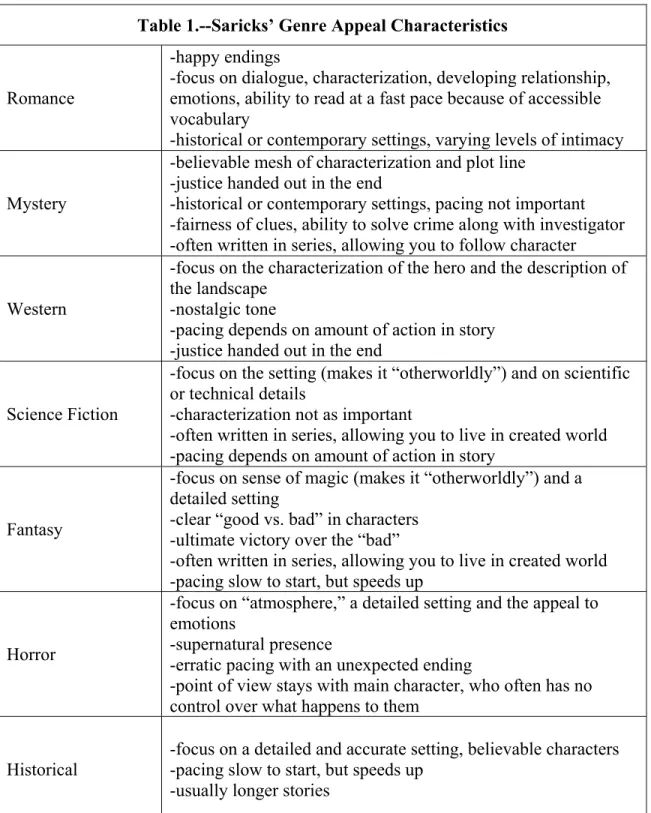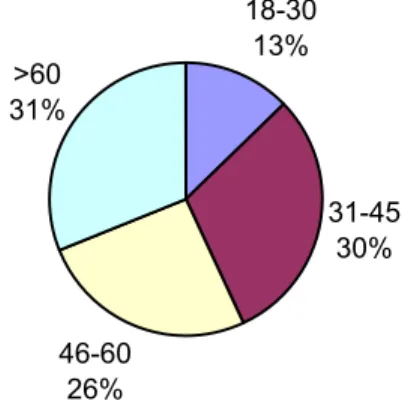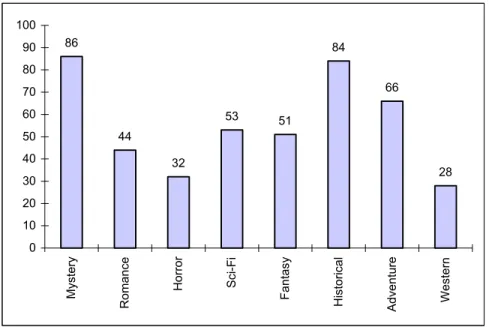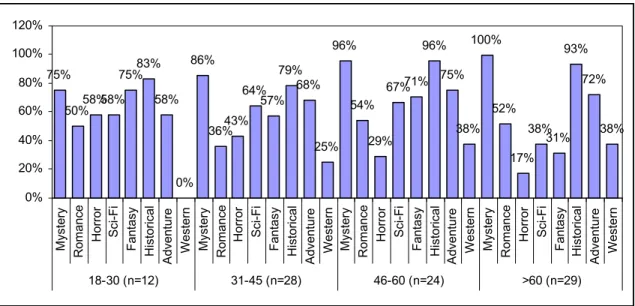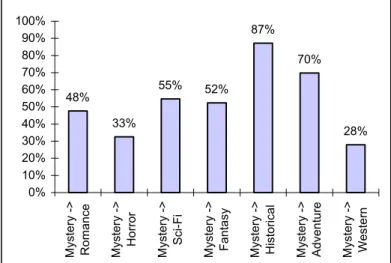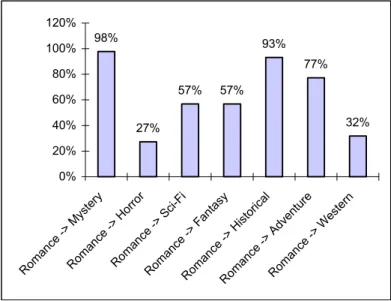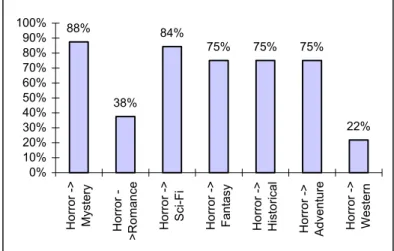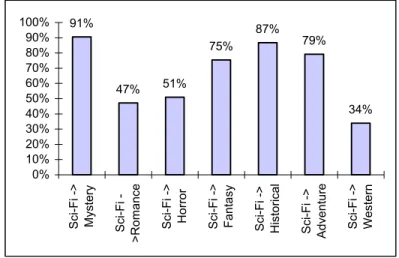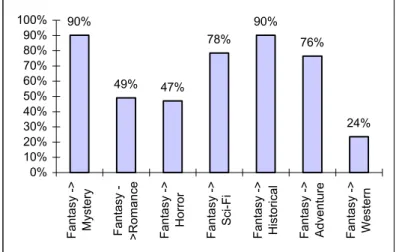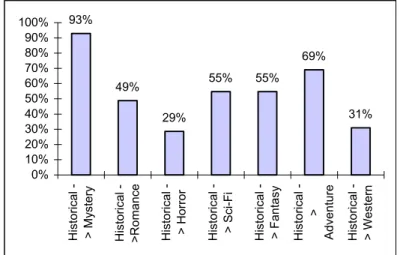Advisor: Barbara B. Moran.
Readers’ advisory services take two forms, direct and indirect. While much research has examined the interaction between a library staff member and a library patron, the equally important area of indirect readers’ advisory has been neglected.
This study describes a questionnaire survey of public library patrons in three branches of the Durham County Public Library system in North Carolina. The survey was conducted to determine if genre fiction reading interests in a local library system reflect common appeal characteristics of those genres and if adult fiction readers use the same vocabulary to describe and talk about fiction genres as do librarians.
Headings:
Public libraries Fiction
PATTERNS OF GENRE FICTION READERS: A SURVEY OF DURHAM COUNTY LIBRARY PATRONS
by
Kathryn R. Gundlach
A Master's paper submitted to the faculty of the School of Information and Library Science of the University of North Carolina at Chapel Hill
in partial fulfillment of the requirements for the degree of Master of Science in
Library Science.
Chapel Hill, North Carolina November, 2002
Approved by:
TABLE OF CONTENTS
TABLES AND FIGURES
Table 1 – Sarick’s Appeal Characteristics _________________________ 13 Table 2 – Genre Vocabulary Discrepancies ________________________ 27
INTRODUCTION
Readers’ advisory services in the public library are expanding rapidly. The implementation of new consultation techniques, training guides, and print and electronic resources makes this an exciting area in an era of increased technological advances. While the public library may be losing ground as a basic information source, people still go there looking for recreational reading materials. Among the various readers’ advisory services, the most traditional practices are the indirect techniques. Often called “passive” readers’ advisory, the term includes the creation of booklists, displays, fiction subject classifications and other promotional materials used to guide the reader to the next book.
Genre fiction plays a major role in readers’ advisory service. Beginning in the 1980’s, readers’ advisory has experienced a rebirth among practicing librarians and within library science programs. While application and integration of the service is stressed, critical study of genre fiction and its readers has yet to be widely undertaken. Genre fiction has traditionally suffered from a stigma attached to reading materials perceived as “lowbrow.” In her recent book, TheReaders’ Advisory Guide to Genre
Fiction, Joyce Saricks promotes the idea of understanding and conveying the appeal
plots are common to both adventure stories and some forms of thrillers. While none of these ideas are new, the preparation and practice of passive or, as Nora Armstrong puts it, “indirect” readers’ advisory does not usually involve much input from patrons, whereas in active readers’ advisory, the service is entirely motivated by the requests of the patron. (Shearer & Burgin 180)
Many patrons are unaware of their librarian’s ability to help them select a book that matches what they desire to read. They do, however, notice the presence of passive readers’ advisory, perhaps without knowing that is what it is. The book displays,
booklists and posters are created by librarians to guide the patron to the next book as well – only not as much in-depth research goes into the forming of these guides. Most of these materials center on a theme such as award-winners or paranormal romances. The inspiration may come from other librarians on the popular mailing list, Fiction-L, or a current blockbuster movie, but it seldom comes from the patrons themselves.
LITERATURE REVIEW
In his essay, “MisReading LIS education,” Wayne Wiegand stresses the importance of studying the reader and reading in library and information science education. He believes the schools have strayed from this course in the last part of the twentieth century due to a focus on technology and information, and thereby produce librarians who are unable to adequately understand and best serve their patrons’ reading needs. “Although in LIS education we are well placed to study the act of reading to understand the public library's social role, with very few exceptions, we have ignored the subject.” (39)
Some of the exceptions include the work done by Kenneth Shearer. Shearer, a professor of library science, has used his students to discover how readers’ advisory is actually conducted in public libraries. In Chapter 1 of Guiding the Reader to the Next Book, Shearer discusses the results of his students’ undercover forays into public libraries armed with basic readers’ advisory questions. In each transaction students approached library employees and asked them to recommend a book similar to a particular title they enjoyed. The transactions that involved questions of what appealed to the reader about the book mentioned tended to have a better level of satisfaction.
time.” (130-1). In order to reach patrons who hold these beliefs, Baker suggests several techniques including using materials displays effectively, fine-tuning booklists,
advertising recently returned books on a shelving cart, and improving fiction categorization in the catalog.
Other fields have studied genre fiction and readers as well. A professor of American literature, specializing in popular fiction, Thomas J. Roberts discusses genre fiction in his book, An Aesthetics of Junk Fiction. He writes, “people who read most often in one genre usually follow other traditions too; they dip into still other genres with moderate frequency; they manifest strong though temporary enthusiasms for something they have just discovered; they develop fierce genre antipathies.” (72) How can readers’ advisory librarians use this knowledge to focus their efforts? Roberts also asserts, “we often speak of readers of popular fiction as though they were simpler and more
predictable than they are.” (71) He goes on to say that readers cannot be grouped by their likes and that most stray from one genre.
Joyce Saricks, whose work was mentioned earlier, has written numerous articles and books about the many topics in readers’ advisory. These topics range from training a librarian to guiding patrons from one genre to another. As previously mentioned, The
Readers’ Advisory Guide to Genre Fiction discusses the latter. In it, she spends a good
exist, could improve non-verbal readers’ advisory services by eliminating some of the guesswork.
Most studies of genre fiction readers produce statistics such as those produced by the international marketing analyst firm, Euromonitor, in an annual readership survey – a listing of genres followed by percentages of persons surveyed who were currently reading a book in that category. The survey also breaks down the responses by gender. (Mann 68-9) The respondents were not asked if the book they were reading was typical of their usual reading taste, or what other genres they might be interested in or read. The
information derived from surveys like the Euromonitor’s only tells librarians what genres are popular and what genres men or women read more of than the other sex. This
information could be gleaned, on a more local level, from the circulation system.
Another problem with studies like these is that they do not define the genre, and answers are subjective. We are not able to tell what a person means when they say they are currently reading a mystery.
themselves. The researchers discerned seven types of fiction borrowers: readers of particularism, readers of frequent/infrequent literary pluralism, readers of
frequent/infrequent recreational pluralism, and readers of frequent/infrequent
universalism. Particularism describes a reader whose reading tastes are very narrow, and not liable to change over time. Literary pluralism denotes readers who only read literary fiction, either frequently or infrequently. Readers who read only recreational or “lighter” fiction, were described as either infrequent or frequent readers of recreational pluralism. Universalism refers to fiction readers who read both recreational and literary fiction in varying frequencies. O’Brien and Yu suggested that these typologies could be used to profile patrons and develop a “sophisticated computerized fiction retrieval system.” (48) This study provides needed information about fiction readers and also hints on ways to improve passive and active readers’ advisory. However, even though the researchers noted the variety of fiction or authors read by the respondents, no specific evaluation of this information was made.
While evident that some study of adult fiction readers and current readers’
METHODOLOGY
This study is designed to answer the following questions: 1. Do genre fiction reading interests in a local library system show patterns that reflect common appeal characteristics and 2. Do adult fiction readers use the same vocabulary librarians use to describe and talk about fiction genres?
While a case study of a library’s circulation figures could have answered the first question posed by the study, direct input from patrons was necessary to examine the second question. It was determined that a patron survey could glean information used to answer both questions.
The survey (see Appendix A) was initially developed based on a reader’s advisory training tool developed by the Adult Reading Round Table of Illinois. The ARRT Genre
Fiction List: A Self-Evaluative Bibliography for Fiction Librarians is a list of seventeen
genres and sub-genres. Each section begins with a brief description of the genre, a mention of classic authors and then a table of current or popular authors well known for writing within that genre. A person using the tool then indicates a level of familiarity with each author listed, beginning with “I’ve read this author” and ending with “I’ve never heard of this author.” In between are “I’ve heard of this author” and ‘I’ve read about this author.”
To create the second part of the survey, each genre description was scaled down and revised with some input from Saricks’ The Readers’ Advisory Guide to Genre
Fiction. The language was simplified as well. The survey was pre-tested by eight
individuals of various backgrounds, but all with a reading interest in genre fiction. Suggestions from the pretest resulted in the addition of the western genre to the second half of the survey in order to have a balanced analysis, as well as a rewording of the science fiction description.
The site of the research was three public libraries in Durham, North Carolina. Fiction circulation numbers revealed the three busiest branches in the Durham County system were Main, Parkwood and Southwest. The questionnaire was handed out to patrons at these branches over a span of three weeks, during October 2002, in an effort to reach most regular library customers, as all fiction circulates for three weeks. Each library was visited at random time periods of two hours, during the day, evenings and weekends to reach the largest variety of patrons. A total of 100 surveys were returned. Five surveys were not used due to completion errors. The responses from the remaining 95 surveys were recorded in data tables for analysis.
response was made in that item, or the corresponding top portion genre was marked “Read Often” or “Read Occasionally,” the missing item was assumed to be “Read.” 3. If an item in the bottom half was not marked or written in, yet the top corresponding genre was marked “Never Read,” then the assumption for the bottom portion would be “Never Read” as well, except in cases where it was clear the respondent did not look at the back page of the questionnaire.
In order to determine current reading interests respondents marking “Read Often” or “Read Occasionally” were grouped together to be considered a reader of that genre. However, to offset the blurring of the distinction between “Read Often” and “Read Occasionally,” these responses were coded differently. “Read Often” was assigned as two points, “Read Occasionally” one point and “Never Read” acted as a zero. This distinction was made in order to determine how frequently respondents read in each genre. While the terms “Often” and “Occasionally” are subjective, they were used to encourage readers of all frequencies to respond proportionally. For instance, if a
respondent only read ten books a year, but six of those were science fiction, this would be “often” in the same sense that a person who reads forty books a year, twenty of which are science fiction, would be considered to read that genre often.
Joyce Saricks’ discusses appeal characteristics in each genre chapter of her book. These appeal characteristics will be used to analyze the results of common reading interests. Table 1 highlights the major appeal characteristics discussed in more length in each of Saricks’ genre chapters.
horror novels attract fantasy readers who are interested in the presence of magic in stories they read? Does the “otherworldliness” common to both science fiction and fantasy novels cause persons to read in both genres?
Table 1.--Saricks’ Genre Appeal Characteristics
Romance
-happy endings
-focus on dialogue, characterization, developing relationship, emotions, ability to read at a fast pace because of accessible vocabulary
-historical or contemporary settings, varying levels of intimacy
Mystery
-believable mesh of characterization and plot line -justice handed out in the end
-historical or contemporary settings, pacing not important -fairness of clues, ability to solve crime along with investigator -often written in series, allowing you to follow character
Western
-focus on the characterization of the hero and the description of the landscape
-nostalgic tone
-pacing depends on amount of action in story -justice handed out in the end
Science Fiction
-focus on the setting (makes it “otherworldly”) and on scientific or technical details
-characterization not as important
-often written in series, allowing you to live in created world -pacing depends on amount of action in story
Fantasy
-focus on sense of magic (makes it “otherworldly”) and a detailed setting
-clear “good vs. bad” in characters -ultimate victory over the “bad”
-often written in series, allowing you to live in created world -pacing slow to start, but speeds up
Horror
-focus on “atmosphere,” a detailed setting and the appeal to emotions
-supernatural presence
-erratic pacing with an unexpected ending
-point of view stays with main character, who often has no control over what happens to them
Adventure
-focus on action, the journey with obstacles to overcome, the setting and a fast-pace
-historical or contemporary setting, varying levels of violence -satisfactory endings, with a form of justice handed out -characterization less important, but often series following character
Adventure, mystery and western novels all end with a form of justice being handed out. Do these genres share readers based on this occurrence? The protagonist in adventures and mysteries often inspire series that allow readers to follow the character, is that commonality enough to draw similar fans? Do the detailed settings, longer stories and similar pacing pull historical fiction readers to fantasy novels?
After reading patterns, the second question this survey examines concerns the reader’s vocabulary and understanding of fiction genres. Two parts of the survey contribute to this effort. The first involves a match-up of the reading interests chosen in the top half of the survey, identified by genre labels, with a genre description in the bottom half of the survey. For example, if a person marks “Read Often” or “Read Occasionally” for mysteries yet marks “Never Read” by the mystery genre description, it could indicate that the person defines mysteries in a different way.
RESULTS AND DATA ANALYSIS Demographics
Of the 95 respondents, 76 were female, 17 male and 2 did not respond to the item. The age breakdown can be seen in Figure 1 below. With the exception of those aged 18-30 years, the range of ages were fairly equally divided.
18-30 13%
31-45 30%
46-60 26% >60 31%
Figure 1--Age Group Breakdown
Fifty-seven percent of the surveys were completed at Durham County’s Main branch, which is located in the heart of Durham, an urban area. Twenty-nine percent were handed out at the Southwest branch, located in a suburban area that caters to a largely middle class family-oriented patron base. The remaining fourteen percent were surveyed at the Parkwood branch. The Parkwood branch is situated in a small strip mall within an older residential neighborhood. The neighborhood contains a variety of families, including long-time elderly residents, a large Indian-American population and an assorted mix of white and black families.
Current Reading Interests
“Read Occasionally” they were considered, in general, as a reader of that genre and counted in the results.
86 44 32 53 51 84 66 28 0 10 20 30 40 50 60 70 80 90 100 Mystery Romance Horror Sci-Fi Fantasy Historical Adventure Western Figure 2 -- Current Reading Interests
The average frequency each genre was read was another result tabulated. As mentioned in the methodology, the three choices of the top half of the survey were coded separately on a 0 to 2 scale. The average score for each genre is shown in Figure 3.
1.51 0.64 0.38 0.68 0.72 1.37 0.87 0.33 0 0.5 1 1.5 2 Mystery Romance Horror Sci-Fi Fant asy
Historical Advent
ure
Western
Figure 3 -- Average of Reading Frequency
overall number of readers seen in Figure 2, there are not many disparities. One obvious difference found between the charts is in the science fiction and fantasy genres. While there are more total science fiction readers than fantasy readers, the fantasy readers tend to read in the genre more frequently on average than the science fiction readers.
A breakdown of current reading preferences by age produces some interesting trends that may be of value to librarians. Figure 4 shows the percentages that result when the number of people in an age group reading a genre is divided by the total number of respondents in that age group. Despite fewer respondents aged 18-30 in the sample, not one of them reads westerns either often or occasionally. This may signal to librarians that as these adults age, westerns will not be in demand. Confirming this speculation is the increasing number of western readers as the respondents’ ages increase.
75% 50%58%58% 75%83% 58% 0% 86% 36%43% 64% 57% 79% 68% 25% 96% 54% 29% 67%71% 96% 75% 38% 100% 52% 17% 38% 31% 93% 72% 38% 0% 20% 40% 60% 80% 100% 120% Myste ry Rom anc e Horror Sci-Fi Fantas y Hi st ori cal A dv enture We ste rn Myste ry Rom anc e Horror Sci-Fi Fantas y Hi st ori cal A dv enture We ste rn Myste ry Rom anc e Horror Sci-Fi Fantas y Hi st ori cal A dv enture We ste rn Myste ry Rom anc e Horror Sci-Fi Fantas y Hi st ori cal A dv enture We ste rn
18-30 (n=12) 31-45 (n=28) 46-60 (n=24) >60 (n=29)
Figure 4 -- Reading Interests by Age Group
than it did to the older age groups in this study. However, this trend may not follow adults as they grow older, stemming from a lowering tolerance for violence or unpleasant reading material.
Mysteries, while popular in all age groups, seem to appeal at an increasing rate the older the age group. Historical fiction and adventure fiction retain similar levels of popularity throughout all four age groups, suggesting a wide appeal. Fantasy fiction fluctuates in popularity across the range of ages, but in general it seems to appeal to younger adults more often than older readers. Romance fiction is not significantly popular among any age group, but remains close to 50 percent in each age category, with the exception of 31-45 year olds.
Crossover Patterns
One of the major focuses of this study was to determine if crossover patterns between genres could be found. To accomplish this, the reading interests marked in the top portion of the survey were broken down by genre. For example, all respondents who marked the genre, Mystery, as either “Read Often” or “Read Occasionally” were grouped together in a separate data sheet and then further analyzed as to what other genres they read. This process was completed for all eight genre reader groups. The results were compared to Saricks’ appeal characteristics listed in Table 1 to find if common characteristics could explain common reading interests.
Mystery
48%
33%
55% 52% 87%
70%
28%
0% 10% 20% 30% 40% 50% 60% 70% 80% 90% 100%
Mystery -> Romance Mystery -> Horror Mystery ->
Sci-Fi
Mystery -> Fantasy Mystery -> Historical Mystery -> Adventure Mystery -> Western
Figure 5--Mystery Readers' Crossover Interests
A high percentage read both historical (87%) and adventure (70%) novels. The lowest percentages, consistent with the previously seen general lack of interest in those genres, also read horror and westerns. These results are consistent with many of Saricks’ appeal characteristic commonalities. Historical mysteries are a very popular subgenre, therefore it is not surprising to see that mystery readers also read historical fiction. In addition to the subgenre link, mysteries often have a similar pacing to historical novels that may draw common readers.
Adventure novels often involve the protagonist in a journey or quest to conquer over the “bad” element, and deal out a form of justice, which is similar to the plot of a mystery novel. Another commonality between the adventure and mystery genres is the trend towards writing in a series that allows readers to follow the protagonist through multiple storylines.
Romance
Despite a general stereotype that most women read romances, only 46 percent of readers surveyed, 76 percent of which were women, did read them. This equals 42 women who read romances either occasionally or often. Indeed, most people who marked “Read Often” under romance also read heavily or widely in many of the other genres listed. The most popular of these genres were mysteries and historical fiction at 98 and 93 percent, respectively (see Figure 6).
98% 27% 57% 57% 93% 77% 32% 0% 20% 40% 60% 80% 100% 120% Roma nce ->
My stery Roma nce -> Ho rror Rom ance -> Sci-Fi Rom ance
-> F antas
y
Rom ance
-> His toric
al
Rom ance
-> Ad ven
ture
Roma nce ->
Wes tern
Figure 6--Romance Readers' Interests
As with mysteries, romance also has a popular sub-genre of historical romances. Many readers blur the distinction between historical novel and romance novel. If a reader feels that a novel has a large amount of accurate historical information, but also involves a romance, they may classify it as historical and not romance.
The extremely high (98%) common interest between romance and mystery readers can be explained by the high percentage of mystery readers among the
considered romantic suspense into the mystery category. For example, best-selling author, Mary Higgins Clark, whom many consider to write romantic suspense, uses elements of the romance and the mystery in all of her novels, making it difficult to classify her work. At Durham County, Mary Higgins Clark’s novels are shelved in the general fiction section, with no special labeling.
The 77 percent of romance readers who also read adventure fiction is somewhat surprising. There are no major shared appeal characteristics found in these two genres. Horror
Horror, the second least read genre category, was read by 34 percent of respondents. As Figure 7 shows, many of the horror readers also read mysteries and science fiction, and three-quarters read fantasy, historical and adventure novels as well.
88%
38% 84%
75% 75% 75%
22%
0% 10% 20% 30% 40% 50% 60% 70% 80% 90% 100%
Horror -> Mystery Horror
->
R
omance Horror ->
Sci-Fi
Horror -> Fantasy Horror -> Historical Horror -> Advent
ure
Horror -> Western
Figure 7--Horror Readers' Interests
fantasy. While both romance and horror novels appeal to a reader’s emotions, they are entirely different sets of emotions.
Science Fiction
Fiction librarians will tell you that science fiction readers are the hardest to assist. They often do not come to the library for their reading material or to the librarian for reading guidance. In this survey, 53 respondents admitted to reading science fiction, but only 12 of those marked “Read Often” in the science fiction genre. The percentages of their other reading interests are in Figure 8.
91% 47% 51% 75% 87% 79% 34% 0% 10% 20% 30% 40% 50% 60% 70% 80% 90% 100% SciFi -> Mystery SciFi -> R omance SciFi -> Horror SciFi -> Fantasy SciFi -> Historical SciFi -> A d vent ure SciFi -> Western
Figure 8--Science Fiction Readers' Interests
Again, the overall high percentage of mystery and historical readers among the respondents may account for their high percentages of 91% and 87%, respectively. A large majority also read in the fantasy, historical and adventure genres. All three of these genres place importance on detailed settings. Fantasy fiction has the otherworldly
Science fiction novels, depending on the author, may involve a lot of action, which would be of common interest to adventure readers as well.
The remaining genres all received less than a majority of crossover readers, which may be attributed to a lack of common appeal characteristics.
Fantasy
Readers of fantasy, another form of speculative fiction, are not known to share science fiction readers’ aversion to the library. However, among respondents there were more science fiction readers than fantasy readers.
90% 49% 47% 78% 90% 76% 24% 0% 10% 20% 30% 40% 50% 60% 70% 80% 90% 100% Fant asy -> Mystery Fant asy ->Ro m a n ce Fant asy -> Horror Fant asy -> Sci-Fi Fant asy -> Historical Fant asy -> Adventure Fant asy -> Western
Figure 9--Fantasy Readers' Interests
As seen in Figure 9, among fantasy readers the most popular of other genres were historical fiction, mysteries, science fiction and adventure novels. Saricks does point out several common appeal characteristics between both fantasy and historical fiction and fantasy and science fiction. Historical novels have a similar pacing, as well as detailed settings and tend to be longer stories. Science fiction, as mentioned before, has an
As in the case of romance readers, there were a significant number of fantasy readers who also read adventure fiction. The only major appeal characteristic in common between adventure and fantasy fiction is the importance placed on detailed settings. Historical Fiction
After mysteries, historical fiction had the highest percentage among the respondents. It is possible that this high rate is the result of general or literary fiction readers seeing historical fiction as the one category on the survey that they read. Another contribution could stem from the number of genres that have “historical” sub-genres, such as mysteries and romances.
93%
49%
29%
55% 55% 69%
31%
0% 10% 20% 30% 40% 50% 60% 70% 80% 90% 100%
Historical - > Mystery Historical - >Romance Historical - > Horror Historical - > Sci-Fi Historical - > Fant
asy
Historical
->
A
d
vent
ure
Historical - > Western
Figure 10--Historical Fiction Readers' Interests
Figure 10 displays the other genre interests of historical fiction readers. With the exception of mystery and adventure readers, there are no remarkable trends. The
Despite most western novels being set in the historic North American West, there were only a small number of common readers. Horror fiction, which has no similar appeal characteristics to historical fiction also produced few crossover readers. Adventure
Another stereotype of female readers is a lack of interest in adventure fiction. That type of fiction is usually assumed to appeal to men. However, 77 percent of adventure readers were female. Their other reading interests are shown in Figure 11.
92% 52% 36% 64% 59% 88% 39% 0% 10% 20% 30% 40% 50% 60% 70% 80% 90% 100% A d vent ure
-> Mystery Advent
ure -> R omance A d vent ure -> Horror A d vent ure -> Sci-Fi A d vent ure -> Fa n ta sy A d vent ure
-> Historical Ad
vent
ure
-> Western
Figure 11--Adventure Readers' Interests
Showing the same trend as historical readers who read adventures, 88 percent of adventure fans read historical fiction. Mysteries were also read by 92 percent of
adventure readers, perhaps because both genres share a theme of meting out justice. Interestingly, 64 percent of adventure readers also read science fiction. While not all science fiction contains a lot of action, there are many writers who include it in their plots.
Only 29 percent of surveyed readers expressed an interest in reading westerns. This low number makes it difficult, as in the case of the horror genre, to find trends in the available data, shown in Figure 12.
89% 50% 25% 64% 43% 93% 93% 0% 10% 20% 30% 40% 50% 60% 70% 80% 90% 100% West ern ->
Mystery Western
-> R omance West ern -> Horror West ern -> Sci-Fi West ern -> Fantasy West ern -> Historical West ern -> A d vent ure
Figure 12--Western Readers' Interests
It is clear that western fiction readers also enjoy mystery, adventure and historical fiction. Most westerns contain elements of adventure and are set in the historic North American West, explaining the similar interests. A popular mystery author, Tony Hillerman, sets the majority of his novels in contemporary Southwest Native American reservations, yet involves a good deal of Native American tradition in them. This fact, coupled with the evidence of ten surveys that had Tony Hillerman written in either the mystery or the western descriptions, may contribute to reasons why surveyed readers chose westerns and mysteries.
Genre Vocabulary
The second focus of this study is whether patrons and librarians use the same vocabulary to discuss genre fiction. As outlined in the methodology, the first way this question is studied is by looking for discrepancies. If respondents mentioned that they read a particular genre in the top half of survey, but failed to mark “Read” in the second half, it may indicate a difference of vocabulary. The same applied if the patron marked “Never Read” on top, but then marked “Read” by the genre description. Table 2 shows, by category, how often this occurred.
Table 2. Genre Vocabulary Discrepancies
Mystery 6 Romance 16 Horror 4 Science Fiction 11
Fantasy 7 Historical 6
Adventure 20
Western 7
The most discrepancies appeared in the adventure genre description, number one in the second half of the survey. Sixteen people also seemed confused by the description of the romance genre.
and 106 title suggestions. The author suggestions matched the genre placement in the Durham County catalog and the genre description on the survey at a higher rate, roughly 68 percent, than did titles, which had only a 50 percent match rate. When checked in the OPAC, more than half of the written-in titles were shelved in the general fiction section. (See Appendix B) It is possible that non-genre fiction readers found common genre descriptors in novels they had read and wrote down those titles.
One of the most common descriptions mismatched was number 4, which described the romance genre. Many people wrote in authors or titles not shelved in romance and in several instances included statements such as “But NOT romance novels!” Another commonly mismatched genre, science fiction, had many non-fiction titles and authors written in. Despite the word, “stories,” to indicate fiction, the problem may have stemmed from the inclusion of “science” in the description.
Other Results
CONCLUSIONS
The findings of this study shed light on genre fiction readers’ interests and highlight areas of genre vocabulary that may be misunderstood. Despite the fact that females constituted a majority of respondents, the information revealed could be used in a general sense. The reading interests of the respondents contradicted some popular
stereotypes of women fiction readers. The results found more adventure readers than romance readers among the largely female sampling, indicating that Durham County librarians could explore non-traditional avenues when promoting their fiction collections.
Many of the linked reading preferences revealed by the survey proved to have several of Saricks’ appeal factors in common. Saricks’ work is the product of over twenty years of genre studies that include both reading in the various genres, and also talking with genre fiction readers. That the majority of respondents’ crossover interests contained appeal elements identified by Saricks is further proof that these elements should be used frequently in non-verbal readers’ advisory services.
love story with a happy ending, despite misunderstandings or circumstances that may keep the two characters apart.” (Appendix A)
The formulaic nature of genre fiction should make it less complicated to understand, but not if a person is unwilling to look beyond the connotations of a label. Public librarians do very little to educate adult readers about the basic facts of the variety of books available. Many librarians’ personal beliefs about genre fiction color their preferences in preparing fiction promotional materials. If patrons see no promotion of a genre that has a negative reputation, they will continue to believe the negative sentiments.
If a library is able to do so, surveying the patrons about their reading interests can help librarians’ focus their collection development and promotional efforts. This study has identified many potential areas Durham County librarians could increase their fiction circulation, and assist their patrons through indirect readers’ advisory techniques.
RECOMMENDATIONS FOR FURTHER STUDY
A 1993 article, “An Inventory of Display Themes: 1933-1992,” chronologically analyzed the subject themes of displays over a sixty year period. The data came from published articles and represented displays created throughout the United States and in several foreign countries. The authors, David Mitchum and Loriene Roy, concluded in their abstract, “themes remained relatively stable over time.” (129) While they examined displays of both non-fiction and fiction materials, Mitchum and Roy did point out that genre fiction displays became popular in the mid-1950s, coinciding with libraries’ taking a more user-centered service orientation. (133-4)
A study of public library fiction displays and/or booklists to determine how often appeal characteristics, as opposed to simple genre headings, are used to promote
materials might prove interesting. Additionally, a comparison of increased circulation figures as a result of genre-specific promotion materials or appeal characteristic-centered materials could strengthen our understanding of what patrons find useful.
WORKS CITED
Adult Reading Round Table of Illinois. ARRT Genre Fiction List: A Self-
Evaluative Bibliography for Fiction Librarians. Arlington Heights,
IL: Adult Reading and Round Table Steering Committee, 1999. Accessed through NoveList, 21 June 2002.
Mann, Peter. “Fiction and the Reading Public.” Peebles '83: Proceedings of the
Ninth Annual Conference of the Scottish Library Association,6-9 June
1983, Glasgow, Ed. Alan G. D. White and Alan J. Taylor. Glasgow:
Scottish Library Association, 1983. 67-75.
Mitchum, David and Loriene Roy. “An Inventory of Library Display Themes: 1933-1992.” Collection Management 18.1/2 (1993): 129-134.
Roberts, Thomas J. An Aesthetics of Junk Fiction. Athens: Univ. of Georgia Press, 1990.
Rosenberg, Betty. Genreflecting: a Guide to Reading Interests in Genre Fiction. Littleton, CO: Libraries Unlimited, 1982.
Saricks, Joyce G. The Readers’ Advisory Guide to Genre Fiction. Chicago: American Library Association, 2001.
Shearer, Kenneth D., ed. Guiding the Reader to the Next Book. New York: Neal-Schuman Publishers, Inc., 1996.
Shearer, Kenneth D. and Robert Burgin, eds. The Readers’ Advisor’s
Companion. Englewood, CO: Libraries Unlimited, 2001.
Yu, Liangzhi and Ann O’Brien. “A Practical Typology of Adult Fiction Borrowers Based on Their Reading Habits.” Journal of Information
APPENDIX A
Rosenberg’s First Law of Reading: “Never apologize for your reading
tastes.”
Please mark your reading preferences:
Genre Read Often Occasionally Never Read Read
Mystery
○
○
○
Romance
○
○
○
Horror
○
○
○
Science Fiction
○
○
○
Fantasy
○
○
○
Historical Fiction
○
○
○
Adventure
○
○
○
Western
○
○
○
Please read the following passages and beside each one indicate whether
you read stories like those described (R), would read stories like those
described (WR), or would never read stories like those described (NR). If
possible, after each section please list any authors or titles you’ve read in that category:
1. Stories with fast-moving plots, exotic settings and larger-than-life heroes. Plots place heroes in death-defying activities (gun battles, car chases, sneak attacks, etc.)
R ○WR ○ NR ○
Authors or titles you’ve read in this category:
2. Stories with elements or basis of magic and/or myth. Plots emphasize journeys, whether psychological or physical, and
often stress the importance of human virtues. Authors or
titles you’ve read in this category:
R ○WR ○ NR ○
3. Stories emphasizing a crime or puzzle presented to a character who then pieces together the answer or the
reasoning behind the commitment of the crime. Authors or
titles you’ve read in this category:
4. Stories appealing to the reader’s emotions. Often include a love story with a happy ending, despite misunderstandings or circumstances that may keep the two characters apart.
Authors or titles you’ve read in this category:
R ○WR ○ NR ○
5. Stories reflecting scientific thought, or how technological
changes affect the human experience. Authors or titles
you’ve read in this category:
R ○WR ○ NR ○
6. Stories set in the North American West, often involving
adventures. Authors or titles you’ve read in this category:
R ○WR ○ NR ○
R ○WR ○ NR ○
7. Stories set in the past that may or may not focus on historical figures, but give us insight into the past.
Authors or titles you’ve read in this category:
R ○WR ○ NR ○ 8. Stories that use elements of the supernatural or occult in
order to frighten the reader. Authors or titles you’ve read
in this category:
Sex: Male
○
Female○
APPENDIX B
Most Popular Author Write-Ins Number of Mentions
Asimov, Isaac 6
Austen, Jane 5
Binchy, Maeve 6
Bradley, Marion Zimmer 7
Card, Orson Scott 6
Chrisite, Agatha 9
Clancy, Tom 7
Clark, Mary Higgins 6
Cornwell, Patricia 10
Crichton, Michael 5
Francis, Dick 5
George, Elizabeth 9
Grafton, Sue 10
Hillerman, Tony 9
James, P. D. 12
King, Stephen 12
Koontz, Dean 8
L'Amour, Louis 6
Maron, Margaret 6
McMurtry, Larry 6
Patterson, James 6
Quick, Amanda 5
Rice, Anne 7
Roberts, Nora 6
Tolkien, J. R. R. 11
Most Popular Title Write-Ins
